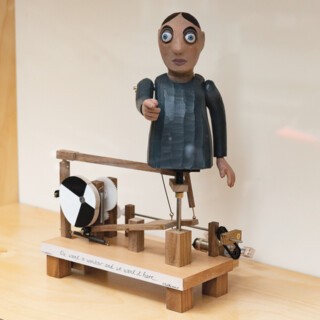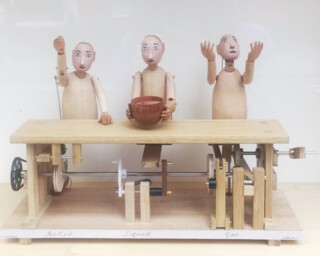Next door to the London Review Bookshop is a firm of architects, Rodić Davidson, who often have interesting displays in their windows. Usually these relate to the tools and forms of their trade, but at the moment they have six stirring, whirling automata created by Paul Spooner. They can be observed in motion on the hour, every hour, but are almost as nice when they are still. Three of them feature animals. One, called Winter, has 16 blackbirds rotating on a number of axes, swooping and cavorting like an errant mobile. It is derived from an earlier version, inspired by the drawings of Johann Knopf, a patient of the German psychiatrist Hans Prinzhorn, who published a book about the ‘Bildnerei der Geisteskranken’, the artwork of the mentally ill. These birds are not entirely animal, however – they have unhappy, human faces. They are less than harpies, but more than scavengers. When the mechanism switches on, they perform an intricate, random-seeming choreography. Because there are so many of them, the eye can’t follow all the different orbits at once and is tricked into thinking there is something spontaneous – natural – about the commotion. The birds are circling around some particular object, perhaps, or out of their own sense of ritual.
In We want a window and we want it here, a small figure, an architect perhaps, draws a square in the air with his outstretched hand. His head moves up and down and his body turns to follow the line of his hand. The fact that he’s facing a window – drawing the pane of glass through which we peer at him – adds something more. The set-up is as simple as possible (you can see a prototype online). A handle is turned, which rotates an oddly shaped wheel. This raises and lowers a small piece of wood to which fine strings are attached, raising and lowering the arm and head. As the wheel revolves in one direction, it allows another, angled wooden block to move into place before pushing it back again. This rotates a central shaft, turning the body of the little man one way, then the other. The mechanism is just as pleasing to watch as the automaton (I particularly like that one piece is designed to do two things) and continues neatly over and over. The idea of the circuit is essential to automata. There used to be an advert for Honda in which a metal nut rolling along a piece of wood set off a chain of reactions through a series of cleverly arranged car parts. It was inspired, though the advertising agency didn’t like to admit it, by The Way Things Go (1987), a 30-minute film by the artists Peter Fischli and David Weiss. Their creation is an example of a Rube Goldberg machine (named after the cartoonist) in which an unlikely number of devices are linked together to create a domino effect – in its original sense the name refers to a machine designed to perform a task in an overcomplicated manner, with as many steps as possible. One of the satisfying aspects of the automaton is that the final motion begins the first again: no overspill, no divergence, no end point.
This potential ceaselessness can also be uncomfortable. What if we cannot switch them off? In Jerome K. Jerome’s story ‘The Dancing Partner’, the automated dancer created by the toymaker Nicholaus Geibel waltzes his partner to death. The natural limits of human activity – our fatigue, our diminishment – are not failings in this context but closely related to human feeling. Perhaps we cling to that notion in the face of a brutal truth: our weak frames can’t survive the rapaciousness of our own creations. But of course that’s not quite true. Machines wear down, batteries run out. Newton’s first and second laws apply. Spooner’s automata are designed to be worked by hand. The ones on display at the architects’ are electronically activated, but thankfully only perform for a few minutes at a time. If they were to chatter all day, we would think they had become deranged and feel exhausted watching them.
Waiting for them to begin is like waiting for a cuckoo clock to chime, and clockmaking is closely bound up with the history of automata. Astronomers, horologists and engineers once shared apparatus and lines of inquiry: mapping speed and trajectory, making visible the passing seconds; stimulating and maintaining movement. With their regular series of small actions, Spooner’s automata keep time. The three wide-eyed wooden figures of Solid, Liquid, Gas don’t aspire to any human naturalness, but perform rigid symbolic gestures. ‘Solid’ taps the table at which they sit with a clasped fist. ‘Liquid’ raises a huge wooden bowl with two hands, as if to drink. ‘Gas’ tilts back and gestures to the air above. They are rough-hewn, overall – the marks of the chisel visible in their domed foreheads – but their hands are fine and expressive. The delicate gold mechanisms allowing arms to bend and lift are where their gracefulness lies. Spooner’s human figures are of a particular sort. They are not dolls, but nor are they intended to look like miniature people. For a long time (and automata go back at least as far as the ancient Greeks) the imagined pinnacle of the automatist’s art was to create a convincing human being. From a purely mechanical point of view, this is impossibly complicated. Around 1800, an automaton that could write a few pre-programmed lines was displayed to great amazement. But no one thought it was a real person. The most convincing human imitations today are digital and unembodied: our physicality remains, for now, out of reach.
Human-like automata are intriguing because they raise questions about how much of our self-determining nature is caused by automatic processes. But it is the fact of movement that I find most interesting. When a leaf flies past the side of our vision, it looks like a bird; when a ball rolls along the floor we think it is a mouse. Purposeful movement suggests a being endowed with life, most often an animal. But there are also thousands of insentient things around us that operate seemingly independently and whose workings we never understand. One of the attractive things about Spooner’s automata is that we can see just how they work – or think we do. Physics for Cats is based on a simple idea, though one inspired by Galileo: a little white mouse runs around a wheel, rotating a sprocket, which releases and catches, causing the plane above it gradually to incline, tipping a black cat backwards and forwards. The cat rolls one way, then as the sprocket gives, he rolls back the other way. I wonder if he thinks he is moving independently.
It is strange that, for all our mechanical sophistication, fantastic inventions have on the whole lost out to the functional. The Pre-Reformation world bustled with religious automata. For hundreds of years engineers created entertainments and contraptions of every sort, and what was useful and what was wonderful weren’t far removed – the same principles governed power looms and table fountains for banquets. In books of ingenious devices from the Middle Ages, the mechanical imagination runs wild in a world of cranks and pulleys; belts, bearings, blocks; gears, ratchets and pawls. That they might have been impossible to realise hardly seems to matter. Spooner’s creations are more modest, but their delicate intricacy and the elegance of their conception, as well as their creator’s slightly offbeat humour (he calls them ‘mechanical jokes for people with short attention spans’), stops quizzical passers-by.
There aren’t many traditional automatists remaining – the field had moved on to robots and modelling for video games – and they are seen now as makers of idiosyncratic toys. Spooner’s are playthings for grown-ups: I’m not sure they would please a child for very long. His entry into the craft was fortuitous. On moving to Cornwall in 1974 he met the artist Peter Markey, who made mechanical sculptures and sold them through a shop in Falmouth called Cabaret. It still survives, though the London outpost, which sat on one of the little streets behind the Royal Opera House, between shops selling stage make-up and technical wizardries, closed in 2000.
Spooner continues to live in Cornwall, in a small village called Stithians, and to delight in the uselessness of his creations:
As well as all the cars, clocks and other machines that make our lives efficient and comfortable, there are quite a lot of machines that have no practical use at all, made by artists who have no interest in efficiency or comfort. They often make machines that express their anger about the dehumanising mechanisation of war, policing, bureaucracy or about the increasing distance between people who seem always to be on the phone but seldom talking to those next to them. My machines are even more useless than those because I’m not even angry, having led an easy life in a beautiful country doing pretty much as I please all day.
His automata celebrate inventiveness for its own sake – not in any amateurish sense, but in the sense of something created for its own entertainment, out of curiosity and displaying individual ingenuity.
Send Letters To:
The Editor
London Review of Books,
28 Little Russell Street
London, WC1A 2HN
letters@lrb.co.uk
Please include name, address, and a telephone number.



